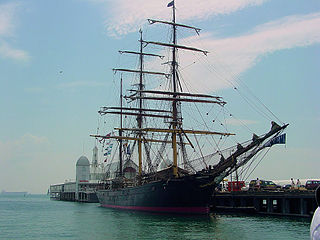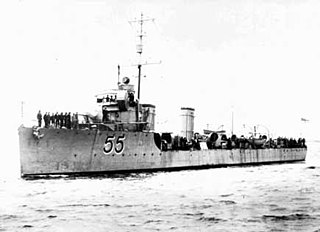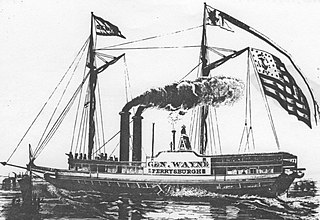
A hulk is a ship that is afloat, but incapable of going to sea. Hulk may be used to describe a ship that has been launched but not completed, an abandoned wreck or shell, or to refer to a ship whose propulsion system is no longer maintained, or has been removed altogether. The word hulk also may be used as a verb: a ship is "hulked" to convert it to a hulk. The verb was also applied to crews of Royal Navy ships in dock, who were sent to the receiving ship for accommodation, or "hulked". Hulks have a variety of uses such as housing, prisons, salvage pontoons, gambling sites, naval training, or cargo storage.

James Craig is a three-masted, iron-hulled barque restored and sailed by the Sydney Heritage Fleet, Sydney, Australia.

HMAS Parramatta, named after the Parramatta River, was a River-class torpedo-boat destroyer of the Royal Australian Navy (RAN). Ordered in 1909 for the Commonwealth Naval Forces, Parramatta was the first ship launched for the RAN. Temporarily commissioned into the Royal Navy for the delivery voyage to Australia, the destroyer came under Australian naval control in 1910, and was recommissioned into the RAN on 1 March 1911, shortly before the latter's formal creation.

HMAS Brisbane was a Town class light cruiser of the Royal Australian Navy (RAN). Built in Sydney between 1913 and 1916 to the Chatham subtype design, Brisbane operated in the Indian Ocean, Pacific Ocean, and Australian coastal waters during World War I.

HMAS Vampire was the third of three Australian-built Daring-class destroyers serving in the Royal Australian Navy (RAN). One of the first all-welded ships built in Australia, she was constructed at Cockatoo Island Dockyard between 1952 and 1959, and was commissioned into the RAN a day after completion.

A prison ship, often more accurately described as a prison hulk, is a current or former seagoing vessel that has been modified to become a place of substantive detention for convicts, prisoners of war or civilian internees. While many nations have deployed prison ships over time, the practice was most widespread in 18th- and 19th-century Britain, as the government sought to address the issues of overcrowded civilian jails on land and an influx of enemy detainees from the War of Jenkins' Ear, the Seven Years' War and the French Revolutionary and Napoleonic Wars.

Edwin Fox is one of the world's oldest surviving merchant sailing ships. The Edwin Fox is also the only surviving ship that transported convicts to Australia. She is unique in that she is the "only intact hull of a wooden deep water sailing ship built to British specifications surviving in the world outside the Falkland Islands". Edwin Fox carried settlers to both Australia and New Zealand and carried troops in the Crimean War. The ship is dry-docked at The Edwin Fox Maritime Centre at Picton in New Zealand.

HMS Nelson was a 126-gun first rate ship of the line of the Royal Navy, launched on 4 July 1814 at Woolwich Dockyard, but then laid up incomplete at Portsmouth until 1854, when work began with a view to commissioning her for service in the Crimean War, but this ended before much work had been done, and the ship returned to reserve.

HMS Little Belt was the mercantile sloop Friends Good Will, launched in 1811, which the British captured shortly after the start of the War of 1812. The British took her into service as Little Belt, armed her with three guns, and incorporated her into the Royal Navy's Lake Erie fleet. The American schooner Scorpion captured her during the Battle of Lake Erie and the Americans took her into service under her existing name. A storm drove her ashore in October 1813 and a British expeditionary force burnt her in December 1813.
Persier was a 5,382 GRT cargo ship which was built in 1918 as War Buffalo for the British Shipping Controller. In 1919, she was sold to Belgium and renamed Persier. Between 1934 and 1941 she also held a passenger certificate. She was driven ashore on the Icelandic coast in a storm in February 1941 which put her out of action for two years. Returned to service in February 1943, she served until 11 February 1945, when she was torpedoed and sunk by U-1017 with the loss of 20 crew.

Fort Victoria was a 7,784 GRT passenger steamship that was built in 1912 as Willochra. During the First World War she was requisitioned for use as a troopship. In 1920 she was sold and renamed Fort Victoria, serving until lost in a collision in 1929.
Phoenix was a three-decker merchant ship built on the Thames in 1798. On a voyage in 1824 on which she first transported convicts to Van Diemen's Land she was damaged on the Sow and Pigs Reef inside Port Jackson Heads, New South Wales, Australia. She was then condemned and turned into a prison hulk. She was broken up in 1837.

SS Aorangi was a passenger and refrigerated cargo ship built by John Elder & Co. of Govan, Glasgow for the New Zealand Shipping Company and launched in 1883. She was chartered by the Royal Australian Navy (RAN) between April 1914 until 1915. In 1915, she was sunk as a blockship at Scapa Flow. In 1920, she was raised but re-sank in Kirk Bay.

Smerch was a monitor built for the Imperial Russian Navy in the early 1860s. She was designed by the British shipbuilder Charles Mitchell and built in Saint Petersburg. The ship spent her entire career with the Baltic Fleet. She ran aground and sank shortly after she entered service in 1865. Smerch was refloated and repaired shortly afterwards. She became a training ship sometime after 1892 and was stricken from the Navy List in 1904. The ship was hulked five years later and renamed Blokshiv No. 2. She was in Finland when that country declared its independence in 1918, but was returned to the Soviets after the Treaty of Brest-Litovsk was signed. Blokshiv No. 1, as the ship was now known, was sunk by German artillery fire in 1941. She was salvaged the following year and remained in service until she was stricken in 1959 and subsequently broken up.

The third HMS Penzance (L28) was a Hastings-class sloop launched in 1930, and torpedoed and sunk in 1940 whilst on convoy protection duty by the German submarine U-37 with the loss of 90 of her 104 crew. She was named after the Cornish port of Penzance and was the third Royal Navy ship to bear that name.

SAS Good Hope was one of three Loch-class frigates in the South African Navy (SAN). It was built as HMS Loch Boisdale (K432) for the Royal Navy during World War II, but was transferred to the SAN before completion in 1944 and renamed as HMSAS Good Hope. The ship was assigned to convoy escort duties in 1945, but did not encounter any enemy ships before the end of the war.
Asia was a merchant ship launched at Calcutta in 1815 for Charles Hackett. She made four voyages transporting convicts from Great Britain to Australia, and between 1826 and 1830, two voyages under charter to the British East India Company (EIC). She was hulked or broken up c.1860.

The PS Anthony Wayne was an early wooden-hulled sidewheel steamship that sank on April 28, 1850, in Lake Erie off the coast of Vermilion, Ohio, after two of her starboard side boilers exploded. The number of people on board the ship at the time of incident is estimated to be about 100. The ship's clerk reported that there were 80 to 100 people on board, which included the crew, with about 30 of them surviving.

PS Lotta Bernard was a wooden-hulled sidewheel steam barge that served on the Great Lakes from her construction in 1869 to her sinking in 1874. She was built in Port Clinton, Ohio, in 1869 by Lewis M. Jackson for S.W. Dorsey of Sandusky, Ohio. When she entered service, she was chartered by the Northern Transportation Company to carry cordwood from the Portage River and Put-in-Bay to Cleveland, Ohio. In 1870, Lotta Bernard was sold to Luman H. Tenney of Duluth, Minnesota. During this time, she was contracted to haul building materials from Bark Bay, Wisconsin, to Duluth to be used in the construction of the first grain elevator in that port. Lotta Bernard was sold to John D. Howard of Superior, Wisconsin, in 1871.

SS Russia was an iron-hulled American Great Lakes package freighter that sank in a Lake Huron gale on April 30, 1909, near DeTour Village, Michigan, with all 22 of her crew and one passenger surviving.




















